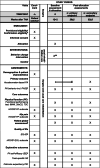Effectiveness of promotion and support for physical activity maintenance post total hip arthroplasty-study protocol for a pragmatic, assessor-blinded, randomized controlled trial (the PANORAMA trial)
- PMID: 35964101
- PMCID: PMC9375375
- DOI: 10.1186/s13063-022-06610-4
Effectiveness of promotion and support for physical activity maintenance post total hip arthroplasty-study protocol for a pragmatic, assessor-blinded, randomized controlled trial (the PANORAMA trial)
Abstract
Background: Total hip arthroplasty is considered an efficacious procedure for relieving pain and disability, but despite that objectively measured physical activity level remains unchanged compared to pre-surgery and is still considerably lower than that of a healthy age- and sex-matched population 6-12 months post-surgery. Since there is a graded relationship between physical activity level and functional performance, increasing physical activity may enhance the outcome of the procedure. This study aims to investigate whether promotion and support of physical activity initiated 3 months after total hip arthroplasty complementary to usual rehabilitation care can increase objective measured physical activity 6 months post-surgery.
Methods: The trial is designed as a pragmatic, parallel group, two-arm, assessor-blinded, superiority, randomized (1:1), controlled trial with post intervention follow-up 6 and 12 months after total hip arthroplasty. Home-dwelling, independent, and self-reliant patients with hip osteoarthritis are provisionally enrolled prior to surgery and re-screened about 2-3 months post-surgery to confirm eligibility. Baseline assessment is conducted 3 months post-surgery. Subsequently, patients (n=200) are randomized to either a 3-month, multimodal physical activity promotion/education intervention or control (no further attention). The intervention consists of face-to-face and telephone counselling, patient education material, pedometer, and step-counting journal. The primary outcome is objectively measured physical activity, specifically the proportion of patients that complete on average ≥8000 steps per day 6 months post-surgery. Secondary outcomes include core outcomes (i.e., physical function, pain, and patient global assessment) and health-related quality of life. Furthermore, we will explore the effect of the intervention on self-efficacy and outcome expectations (i.e., tertiary outcomes).
Discussion: By investigating the effectiveness of a pedometer-driven, face-to-face, and telephone-assisted counselling, behavior change intervention in complementary to usual rehabilitation, we hope to deliver applicable and generalizable knowledge to support physical activity after total hip arthroplasty and potentially enhance the outcome of the procedure.
Trial registration: www.
Clinicaltrials: gov NCT04471532 . Registered on July 15, 2020.
Keywords: Behavior change intervention; Motivation; Pedometer; Physical activity; Physical function; Randomized controlled trial; Total hip arthroplasty.
© 2022. The Author(s).
Conflict of interest statement
The authors declare that they have no competing interests.
Figures



Similar articles
-
Improving physical activity, pain and function in patients waiting for hip and knee arthroplasty by combining targeted exercise training with behaviour change counselling: study protocol for a randomised controlled trial.Trials. 2018 Aug 7;19(1):425. doi: 10.1186/s13063-018-2808-z. Trials. 2018. PMID: 30086780 Free PMC article.
-
SuRxgWell: study protocol for a randomized controlled trial of telemedicine-based digital cognitive behavioral intervention for high anxiety and depression among patients undergoing elective hip and knee arthroplasty surgery.Trials. 2023 Nov 9;24(1):715. doi: 10.1186/s13063-023-07634-0. Trials. 2023. PMID: 37946291 Free PMC article.
-
Mobile rehabilitation support versus usual care in patients after total hip or knee arthroplasty: study protocol for a randomised controlled trial.Trials. 2022 Jul 8;23(1):553. doi: 10.1186/s13063-022-06269-x. Trials. 2022. PMID: 35804429 Free PMC article.
-
Evaluation of Exercise Interventions and Outcomes After Hip Arthroplasty: A Systematic Review and Meta-analysis.JAMA Netw Open. 2021 Feb 1;4(2):e210254. doi: 10.1001/jamanetworkopen.2021.0254. JAMA Netw Open. 2021. PMID: 33635329 Free PMC article.
-
Personalized remotely guided preventive exercise therapy for a healthy heart (PRIORITY): protocol for an assessor-blinded, multicenter randomized controlled trial.Front Cardiovasc Med. 2023 Jun 29;10:1194693. doi: 10.3389/fcvm.2023.1194693. eCollection 2023. Front Cardiovasc Med. 2023. PMID: 37456813 Free PMC article. Review.
Cited by
-
Health Professionals' Motivational Strategies to Enhance Adherence in the Rehabilitation of People with Lower Limb Fractures: Scoping Review.Int J Environ Res Public Health. 2023 Nov 10;20(22):7050. doi: 10.3390/ijerph20227050. Int J Environ Res Public Health. 2023. PMID: 37998282 Free PMC article.
References
-
- Castell MV, van der Pas S, Otero A, Siviero P, Dennison E, Denkinger M, et al. Osteoarthritis and frailty in elderly individuals across six European countries: results from the European Project on OSteoArthritis (EPOSA) BMC Musculoskelet Disord. 2015;16:359. doi: 10.1186/s12891-015-0807-8. - DOI - PMC - PubMed

